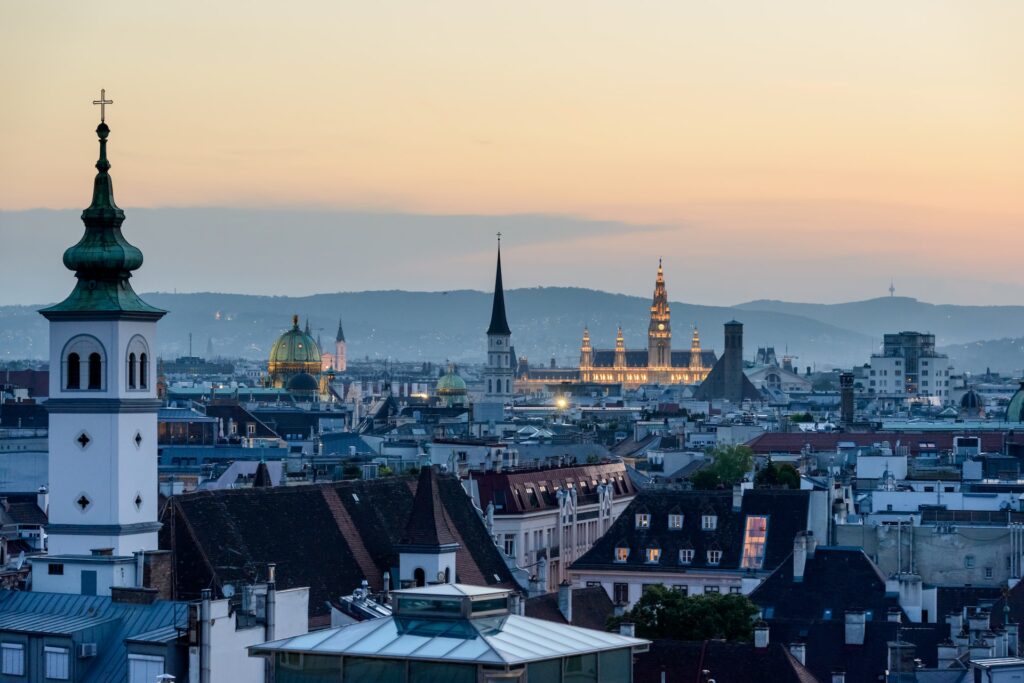The public transportation system of Vienna, Austria, is called the U-Bahn. There are five lines that make up this system: U1, U2, U3, U4, and U6, which together encompass 104 kilometers of track and serve 92 stops. Every day from 5 am to 12:30 am, the U-Bahn works as a rapid transport system. There are tickets and monthly passes available, and it is a dependable and affordable way to move around Vienna. The tram and S-Bahn systems, as well as other public transportation networks, are well connected to the Vienna U-Bahn.
Basic information about the Metro system in Vienna
The Vienna metro system makes getting around the city easy and convenient. There are five lines in total—U1, U2, U3, U4, and U6—and they serve the majority of the city. It is simple to determine which line you are taking because each line is distinguished by its color and number. From 5 a.m. to midnight, the metro runs, with weekend service being longer. You can switch between lines at the many accessible transfer locations. Vienna’s metro system is a fantastic method to travel quickly throughout the city.
The lines of the Vienna subway system
A vital component of Vienna’s robust public transit network are the metro lines. The Vienna subway system has five lines that go through the heart of the city and make it simple to get to many different areas.
Line U1 (Red)
From Leopoldau in the north to Reumannplatz in the south, the U1 line is located. As it passes through the center of Vienna, this is one of the busiest lines. Numerous other significant stations, like the Prater, Stephansplatz, and Karlsplatz, are also traversed. Given that it connects several of the city’s most well-known sites, the U1 line is useful for tourists. The Schönbrunn Palace, the Vienna Woods, the Vienna State Opera, and the Belvedere Palace are all widely accessible to tourists. Major shopping districts including Kärntnerstrasse and Mariahilferstrasse are also served by the U1 line. Both locals and visitors choose the U1 line because of its accessible stations and popularity.
Line U2 (Purple):
Seestadt in the east and Ober St. Veit in the west are connected by the U2 line. The Vienna State Opera and Schonbrunn Palace are two of the prominent tourist destinations that are traversed by this line. Many of the city’s main shopping districts, including Graben, Kärntner Strasse, and Mariahilfer Strasse, are also traversed by the U2 line. The well-known U-Bahnhof Stephansplatz, which acts as the primary hub for Vienna’s U-Bahn and S-Bahn lines, is another stop on the route.
Line U3 (Orange):
Ottakring in the west and Simmering in the east are connected by the U3 line. Many of Vienna’s most tranquil areas, like the Untersberg region, are traversed by this route. Without needing to go into the city center, the U3 line is a terrific way to discover Vienna. It is a fantastic way to explore the city and its distinctive neighborhoods. Travelers can stop along the journey to see the numerous parks, gardens, and monuments that make Vienna such a lovely city. Additionally, it is the ideal time to visit some of Vienna’s neighborhood cafés and eateries, which serve a wide selection of delectable dishes and beverages. Without having to travel too far, the U3 line is the ideal way to explore the finest of Vienna.
Line U4 (Green):
The U4 line connects Heiligenstadt in the east with Hütteldorf in the west. Since it travels through some of Vienna’s residential areas, this line—the only one that does not go through the city center—is still well-liked by commuters. As the only line that travels the entire length of Vienna, the U4 is a fantastic way to get rapidly through the city. It connects to other public transportation lines like the U1 and U2, as well as some of the most well-known tourist destinations like Schönbrunn Palace. The U4 is an excellent way to get some fresh air during the day because it also travels past some of Vienna’s open parks.
Line U6 (Brown):
Floridsdorf in the north and Siebenhirten in the south are connected by the U6 line. The Vienna Zoo and the Belvedere Palace are two of the city’s most popular tourist destinations that are traversed by this line, which is the longest of all. It also passes the Vienna State Opera and the University of Vienna, as well as other of the city’s well-known commercial avenues like Kärntnerstrasse and Mariahilferstrasse. Additionally, it transports passengers to some of Vienna’s most beautiful parks and gardens, including the Volksgarten and the Stadtpark. Both tourists and locals love the U6 line’s efficiency and comprehensive coverage of Vienna’s attractions.
The Vienna subway system’s lines are all pristine, secure, and effective, making them excellent transportation options. Finding the best line for you is simply because of the variety of stops and itineraries. The Vienna metro lines are a terrific method to travel around the city whether you are commuting, sightseeing, or just exploring it.
Map of Vienna Metro 2023 – Free Download in PDF

Anyone visiting Vienna should have a copy of the Vienna Metro Map 2023. The map is simple to obtain and utilize because it is freely downloadable in PDF format. The city’s principal lines, stops, and landmarks are all included, along with any ongoing development or changes to the public transportation system. Both visitors and locals can traverse the city swiftly and easily with the help of the Vienna Metro Map 2023.
Public transport tickets in Vienna – Best types for travelers & actual prices
Although Vienna is a wonderful city to explore on foot, purchasing public transportation tickets is necessary if you want to go farther. Vienna has a vast network of trams, buses, and underground trains, and there are many places to buy tickets. This article will give a general summary of the many ticket options, their costs, and where to purchase them.
There are three main types of public transport tickets in Vienna:
- single tickets
- day tickets
- Vienna Card
Single tickets are valid for one journey, on any mode of public transport, within the city limits. They cost €2.40 per journey and can be purchased at ticket machines located at most public transport stops. Day tickets are valid for 24 hours from the time of purchase and cost €8. They cover all forms of public transport within the city boundaries and can be bought at ticket machines, ticket offices or on board vehicles.
Which choice is most suitable for tourists?
Visitors who intend to stay in the city for more than a day or two might consider the Vienna Card. It costs €14.90, €21.90, or €24.90 and is good for 24, 48, or 72 hours. The Vienna Card offers discounts on numerous attractions and activities in addition to free public transportation. You can buy it at the Vienna Tourist Office or online. When visiting Vienna, the Vienna Card is a great way to save money. All forms of public transportation, including buses, trams, the subway, and even trains to the airport, accept it. Additionally, you can get discounts of up to 50% on tourist attractions including museums, sightseeing tours, and even the Vienna State Opera. The card also includes discounts at restaurants and shops. With all these benefits, it’s no wonder that the Vienna Card is such a popular choice among travelers.
For individuals arriving in Vienna from outside the city, there are tickets available. These include the Vienna Regional Ticket, which has a one-day validity and is good for all forms of public transportation both inside and outside of the city of Vienna. It is available at ticket booths, ticket offices, and onboard vehicles for the price of €13.60.
In conclusion, Vienna offers a variety of public transportation tickets to meet any demand. For those traveling within the city, single tickets are the most practical and economical choice; for those planning to see more of the country, the Vienna Card is the best alternative. In Vienna, there is bound to be a ticket to fit your needs, regardless of your spending limit or trip itinerary.
Summary of fares for public transport in Vienna
- Single tickets valid for one journey within city limits, cost €2.40 and can be purchased at ticket machines
- Day tickets valid for 24 hours, cost €8 and can be bought at ticket machines, ticket offices or onboard vehicles
- Vienna Card valid for 24, 48 or 72 hours, costs €14.90, €21.90 or €24.90 respectively, includes free public transport and discounts on attractions and activities
- Vienna Regional Ticket valid for one day, covers public transport within Vienna city limits and to and from airport, costs €13.60, can be bought at ticket machines, ticket offices or onboard vehicles
Timetables & Schedules of Vienna Metro system
The extensive and effective Vienna metro system offers a means of getting around the city. On weekdays, it’s open from about 5:00 am to 12:30 am, and on weekends, it’s open from 6:00 am to 12:30 am. In Vienna, trains normally arrive every 5 to 10 minutes and provide consistent service throughout the day. The Vienna Metro map is made to make it simple to navigate the city; each metro line is designated by a number and a color. The Metro’s online route planner is available for anyone to utilize to choose the most efficient route for their trip.
What Are Other Options For Public Transportation In Vienna?
One of the most populated cities in the EU, Vienna offers an abundance of public transit choices to its residents. There are many other ways to move around Vienna besides the metro, despite the fact that it is one of the most well-liked modes of transportation. We’ll look at a few of the additional Vienna public transit alternatives below.
Extensive bus network
The bus system is one possibility. Bus lines in Vienna cover a large portion of the city and its surrounding suburbs. The buses are reasonably priced and operate on a set timetable. Numerous Vienna landmarks, attractions, and transportation options may all be reached by bus.
Large tram network
The tram system is yet another choice. There are many tram routes in Vienna that cover much of the city and its surrounding suburbs. The trams are dependable, effective, and reasonably priced. They are an excellent method to navigate the city and reach many of the landmarks and attractions. The trams are also highly practical because you can simply travel where you need to go because they have numerous stops all around the city. Additionally, you won’t have to worry about missing the final train because they run late into the night. Vienna is very accessible for both visitors and locals thanks to the tram network.
S-Bahn & U-Bahn & Regional trains
The railroad system is the third alternative. The vast majority of the city and its neighboring suburbs are serviced by Vienna’s train network. Getting to Vienna and to many of the sites and landmarks is simple and reasonably priced by trains. The S-Bahn, U-Bahn, and Regional Trains are only a few of the networks that make up the Vienna train system. The S-Bahn is an on-road commuter train that links the city’s core to the nearby suburbs. Many of the major attractions in the city center are connected by the U-Bahn, an underground fast transit system. The Regional Trains provide service to certain foreign locations as well as other cities in Austria. All three networks are connected and offer easy access to a variety of destinations.
How To Get From Vienna International Airport (VIE) To The City Center BY Public Transport?
Public transportation makes it simple and convenient to get from Vienna International Airport to the city center. A variety of modes of transportation, including cabs, buses, and trains, are readily available in Vienna, a significant international hub with good connections.
Vienna Airport Lines shuttle service
The Vienna Airport Lines shuttle service is the quickest and most practical method to get from Vienna International Airport to the city center. You can use this door-to-door shuttle service to get from the airport to any chosen location, including your hotel in the heart of the city. Tickets can be purchased online or at the bus station, and the service is available around-the-clock. Depending on traffic, it takes about 20 minutes to travel.
CAT train
Take the CAT train from the airport to Vienna’s Hauptbahnhof if you want a less expensive option (main train station). Every 30 minutes, this fast train departs, and the trip only takes 16 minutes. You can then change to the U-Bahn or S-Bahn to get to your selected location in the city center from the Hauptbahnhof.
S-Bahn
You can also use the S-Bahn to travel from the Vienna Airport to the city center. The S-Bahn station is right outside the arrivals area, and the trip to the city center takes around 30 minutes. Prior to boarding, you must purchase a ticket from one of the ticket machines at the station.
FREE ride on BOLT! The most convenient way
Finally, if you prefer to take a taxi, you can easily find one at the airport. Taxis are available 24/7, and the journey to the city center will take approximately 30 minutes, depending on traffic.
Getting from Vienna International Airport to the city center is simple and straightforward. Whether you are looking for a speedy high-speed train or a more affordable option, there are plenty of options available.
What kind of sightseeing DO you have to see if you visit Vienna for THE first time?
Austria’s vivacious capital city of Vienna is a metropolis rich in history, culture, music, and the arts. Vienna is one of the most visited cities in Europe because of its imperial palaces, top-notch museums, lovely parks, and medieval churches. There are many sights to discover in Vienna, whether you’re a frequent tourist or a local. The top Vienna tourist destinations are listed below.
One of Vienna’s most popular tourist destinations is the Schönbrunn Palace. Grand and baroque in design, it is a protected UNESCO World Heritage Site. The palace boasts a zoo and 1,441 rooms in addition to a lovely landscape. Visitors can tour the gardens and inside of the palace, where there are numerous works of art. The Kunsthistorisches Museum is one of the most significant art museums in Europe and the largest art museum in Austria. There is a sizable collection of European artwork there, from the Middle Ages to the present, including Rubens, Rembrandt, and Van Dyck pieces. The museum also houses significant items from Egypt and Greece, as well as a well-known collection of coins and medals.
A further Vienna must-see attraction is the Belvedere Palace. The famed Klimt paintings, some of the most expensive and recognizable works of art in the entire world, are kept in this Baroque palace complex. In addition, the Palace is home to two museums and a number of lovely gardens. The Vienna State Opera House is another well-known Vienna landmark. The Vienna State Opera and Vienna Philharmonic Orchestra are housed in this renowned opera theatre. Visitors can attend a classic opera or ballet performance or have a guided tour of the opera house. The Hofburg Palace is the former imperial palace of the Habsburgs and one of the most important buildings in Vienna. The palace is home to several museums, galleries, and cafes, as well as the Spanish Riding School, where you can watch the famous Lipizzaner horses perform. The Prater is Vienna’s most famous amusement park. Located in the city’s center, the Prater has over 250 rides and attractions, including a giant Ferris wheel, roller coasters, and a haunted house.
These are but a few of Vienna’s best tourist destinations. Vienna offers something for everyone, whether you’re seeking a cultural experience or a surge of excitement. Plan your vacation now to take advantage of the many attractions that this energetic city has to offer.
Summary of our tour guide for Vienna
Austria’s capital city, Vienna, is renowned for its vibrant culture, significant historical sites, and lovely parks. It is a thriving metropolis with a first-rate public transportation network that links the city to its numerous suburbs. Vienna’s well-organized network of trams, buses, and trains makes getting around the city simple, but the U-Bahn subway system is the quickest. Vienna is a fantastic choice for cyclists because it boasts a wide variety of bike lanes and trails. Vienna is a city that is simple to visit because of its diverse cultural offers, secure streets, and effective public transportation.
Top 5 FAQs and answers about Vienna public transport?
- How early should I get to Vienna airport?
- Prior to your journey, you should make sure to arrive at the airport well in advance. We advise two hours for domestic flights and up to six hours for international ones.
- Is Vienna tourist card worth it?
- Vienna Pass is totally worth the cost. The pass includes free admission to all the popular attractions, a boat cruise, a hop-on-hop-off bus tour and a walking tour. You can save up to €70 for 3 days using the pass. Vienna Pass is the best way to explore the city and save a lot of money.
- How do you pay for Vienna trams?
- Tickets must be validated before boarding. To validate your ticket stamp the ticket at the blue machines located at the entrance of underground stations as well as on buses and trams. Tickets bought directly from the tram or bus driver are automatically validated and need not be stamped again.
- Is Vienna a walkable city?
- People in Vienna make 28 percent of their journeys on foot. A number of walking routes let you discover the city at your leisure.
- How many days in Vienna is enough?
- We think that three days in Vienna is the perfect amount of time for a visit. Three days will let you see the majority of the main sights in this beautiful city that you’re interested in, plus add in a few of the less well-known attractions, without being too rushed.
Useful links







